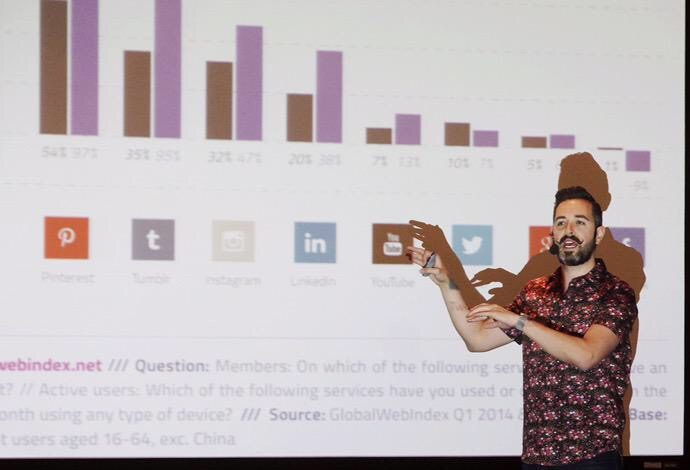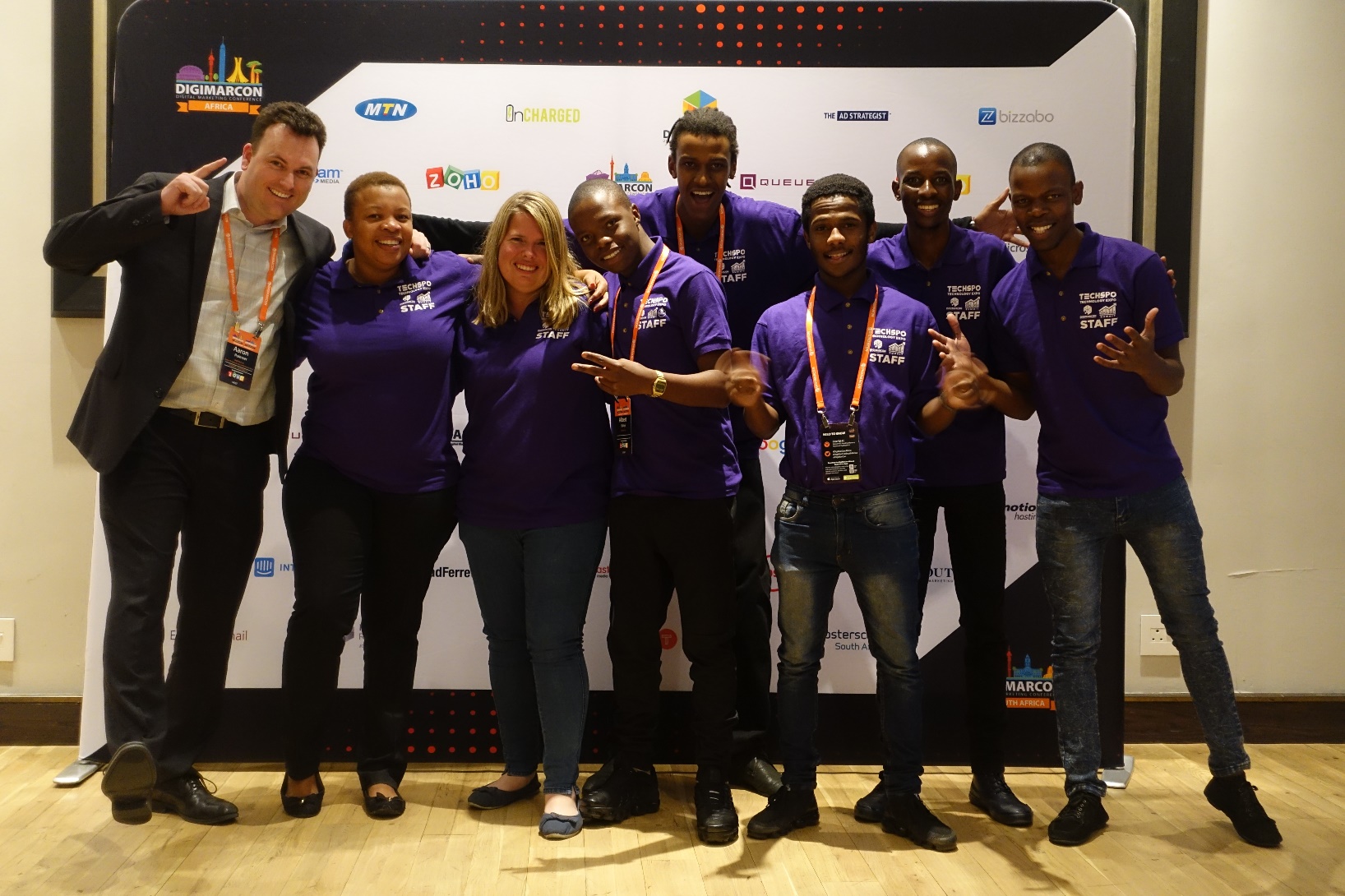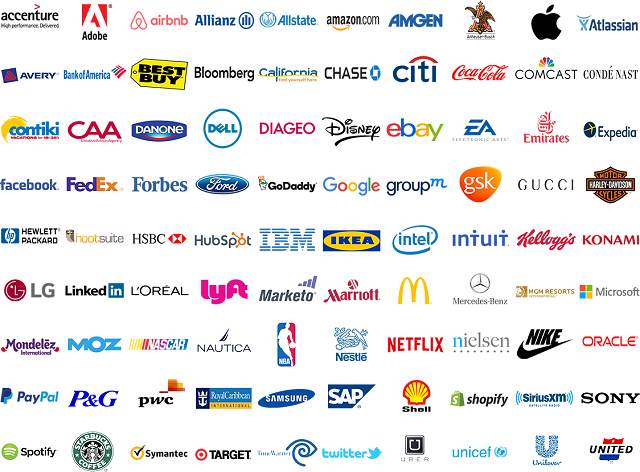Posts Tagged "Social Media Engagement"
Articles
- Best Marketing Conference Sponsorship
- What Does it Mean to Be an Exhibitor at a Conference?
- What Is the Biggest Social Media Conference?
- What Is an Innovation Conference?
- What Is a Typical B2B Event?
- What Are the Cloud Technology Events in 2025?
- Marketing Event Volunteer Opportunities: A Comprehensive Guide
- Digital Marketing Event Volunteer Opportunities Near Me
- What Does a Volunteer Do at a Conference?
- Is DigiMarCon Worth It?
- Is DigiMarCon Good?
- What is the Biggest Marketing Forum?
- What are Digital Marketing Conferences?
- Marketing Conference Exhibiting: Your Guide to Success
- Digital Summit Comparison: A Closer Look at DigiMarCon
- Digital Marketing Conference
- Digital Marketing Events: Your Guide to Success in 2025
- Marketing Conferences: Unlocking Your Business Potential in 2025
- What Is The Future of Digital Marketing in 2030?
- B2B Event Marketing Strategy: Unlocking Success For Your Business
- Why B2B Event Marketing?
- What Should a B2B Marketing Strategy Include?
- Top Marketing Conferences for 2025
- What Is the Future of Marketing in 2025?
Digital Marketing Conferences
- NORTH AMERICA
- DigiMarCon Cruise
(New Orleans, LA, USA) - DigiMarCon West
(Los Angeles, CA, USA) - DigiMarCon Northwest
(Seattle, WA, USA) - DigiMarCon Canada West
(Vancouver, BC, USA) - DigiMarCon Canada
(Toronto, ON, Canada) - DigiMarCon Canada East
(Montreal, QC, Canada) - DigiMarCon Florida
(Orlando, FL, USA) - DigiMarCon Gulf Coast
(Houston, TX, USA) - DigiMarCon Southern California
(San Diego, CA, USA) - DigiMarCon Midwest
(Chicago, IL, USA) - DigiMarCon Mid-South
(Nashville, TN, USA) - DigiMarCon Great Lakes
(Detroit, MI, USA) - DigiMarCon North
(Minneapolis, MN, USA) - DigiMarCon Central
(Kansas City, MO, USA) - DigiMarCon Texas
(Dallas, TX, USA) - DigiMarCon New England
(Boston, MA, USA) - DigiMarCon Mid-Atlantic
(Philadelphia, PA, USA) - DigiMarCon South Florida
(Miami, FL, USA) - DigiMarCon Southeast
(Atlanta, GA, USA) - DigiMarCon Central Florida
(Tampa, FL, USA) - DigiMarCon East
(New York, NY, USA) - DigiMarCon South Atlantic
(Charlotte, NC, USA) - DigiMarCon America
(Washington, D.C. USA) - DigiMarCon Northern California
(San Francisco, CA, USA) - DigiMarCon Rocky Mountains
(Denver, CO, USA) - DigiMarCon South
(San Antonio, TX, USA) - DigiMarCon Silicon Valley
(San Jose, CA, USA) - DigiMarCon Orange County
(Anaheim, CA, USA) - DigiMarCon Southwest
(Phoenix, AZ, USA) - DigiMarCon World
(Las Vegas, NV, USA)
- DigiMarCon Cruise
- LATIN AMERICA
- EUROPE
- MIDDLE EAST
- AFRICA
- ASIA PACIFIC
- DigiMarCon Hawaii & Pacific
(Honolulu, HI, USA) - DigiMarCon Asia & Japan
(Tokyo, Japan) - DigiMarCon New Zealand
(Auckland, New Zealand) - DigiMarCon Australia
(Sydney, Australia) - DigiMarCon Oceania
(Melbourne, Australia) - DigiMarCon Southeast Asia
(Singapore) - DigiMarCon India
(New Delhi, India) - DigiMarCon North Asia & China
(Shanghai, China)
- DigiMarCon Hawaii & Pacific
- VIRTUAL
Digital Marketing Blog
- DigiMarCon for Startups: Why Founders Shouldn’t Miss It October 29, 2025
- DigiMarCon Recap: What Went Down and What’s Next October 29, 2025
- The Best Quotes from DigiMarCon That Will Inspire Your Next Campaign October 29, 2025
- Innovations Unveiled: The Coolest Tech at DigiMarCon Conference & Exhibition October 29, 2025

































Unlock Website Traffic Growth: 10 Proven Hacks to Try
In today’s digital world, being seen online is key for businesses to grow. Website traffic growth is a top goal for companies. They look for new ways to get more people to visit their sites.
Studies show businesses want to find effective ways to get more site visitors. We’ve gathered a list of 10 proven hacks to boost your online traffic. These tips can help your business succeed.
Key Takeaways
The Strategic Value of Driving More Website Visitors
Getting more people to visit your website is key in digital marketing. But, it’s not just about how many visitors you get. The quality of those visitors matters a lot. It affects how well your online presence works.
Why Traffic Quality Matters More Than Quantity
Getting the right people to visit your site is crucial. A study by HubSpot shows that focusing on SEO helps a lot. SEO brings in better traffic that’s more likely to interact with your content.
Setting Realistic Traffic Growth Goals
To grow your traffic in a meaningful way, you need to set goals that are realistic. You should know who your audience is, look at your competitors, and find ways to make your site more visible. Setting goals that you can reach helps you focus on strategies that increase organic traffic.
Measuring Success Beyond Just Visitor Numbers
Success on your website isn’t just about how many people visit. You also need to look at engagement, conversion rates, and bounce rates. These metrics give you a full view of how your site is doing. By using them, you can make your organic traffic strategies better and improve your site’s performance.
To boost website SEO, focus on quality traffic and set realistic goals. This way, you can grow your traffic in a meaningful way and meet your marketing goals.
Hack #1: Optimize Your Content for Featured Snippets
Optimizing your content for featured snippets can greatly improve your website visibility. It also helps drive more traffic to your site. Featured snippets are short summaries that show up at the top of Google’s search results. They give users a quick answer to their questions.
How Featured Snippets Drive Significant Traffic
A study by Ahrefs found that featured snippets can boost website traffic by up to 20%. They are very visible and often get clicked more than other search results. By making your content snippet-friendly, you can increase your online presence and draw more visitors.
Formatting Content for Snippet Optimization
To make your content snippet-friendly, format it for search engines. Use clear headings, short paragraphs, and structured data.
List-Based Snippet Formatting
List-based content works well for featured snippets. It gives a clear, concise answer to the user’s question. Use
or
tags to structure your list.
Paragraph Snippet Optimization
For paragraph snippets, aim for a clear, concise answer. Use short paragraphs and avoid jargon or technical terms.
Tools to Track Featured Snippet Opportunities
Several tools can help you find featured snippet opportunities. Ahrefs, SEMrush, and Moz are some examples. They show you which keywords and content are featured, helping you optimize your content.
As
, optimizing for featured snippets needs a strategic approach. But the benefits are worth it.
Hack #2: Leverage the Skyscraper Technique for Link Building
The Skyscraper Technique is a strong link building method. It helps websites grow their online presence. You find top content in your field, make it better, and then ask other sites to link to it.
Finding Top-Performing Content in Your Niche
To use the Skyscraper Technique, first find the best content in your field. Use tools like Ahrefs or SEMrush for this. Look at shares and backlinks to see what people like.
A study by Moz shows that good backlinks help content rank better. This is important for your site’s success.
Creating Superior Content That Outranks Competitors
After finding great content, make something even better. Update stats, add new insights, or improve visuals. This makes your content more valuable and linkable.
For example, if someone has “10 tips,” make a guide with “20 tips.” This gives more value to readers.
Outreach Strategies for Maximum Link Acquisition
Once you have great content, it’s time to reach out. Find sites and influencers that might link to you. Make your emails personal by explaining why your content is good for their audience.
A study shows that personal emails get more responses. This can lead to more backlinks.
Email Outreach Templates That Work
Good email templates can make link building easier. Your template should introduce yourself, explain your content’s value, and ask for a link. For example, say, “I loved your article on [topic]. I made an even better version that I think your readers will like.”
Following Up Without Being Pushy
It’s important to follow up on your email without being too pushy. A polite second email can help a lot. Wait a few days before following up to give the other person time.
Hack #3: Implement Strategic Internal Linking Architecture
Strategic internal linking is key to a better website. It makes your site easier to navigate and boosts search rankings. This approach also improves user experience and keeps visitors engaged.
Identifying Your Pillar Content Pages
Pillar content pages are the heart of your site’s linking structure. They’re in-depth, high-quality pages that focus on a single topic. Look for content that:
Creating Topic Clusters Around Main Themes
Topic clusters group related content around a main theme or pillar page. This approach:
A SEMrush study found that internal linking can increase website traffic and engagement. By linking smartly to and from pillar pages, you spread link equity and make related content more visible.
Using Internal Links to Boost Underperforming Pages
Internal linking can breathe new life into underperforming pages. Linking these pages from high-traffic or pillar pages can increase their visibility. Here are some strategies:
Hack #4: Optimize for Voice Search Queries
Voice search is getting more popular, and it’s important to make your content voice-friendly. A Google study shows many people now use voice assistants for searching. This means you need to make your content work well for voice search.
Understanding Voice Search Behavior Patterns
Voice search users talk more like they’re having a conversation. They ask questions directly. For example, they might say, “What are the best restaurants in New York?” instead of typing it.
Incorporating Conversational Long-Tail Keywords
To get better at voice search, use conversational long-tail keywords. This means using phrases that sound like how people speak. For example, instead of “best Italian restaurants,” try “What are the top-rated Italian restaurants near me?”
Creating FAQ Content Specifically for Voice Search
FAQ content is great for voice search. By answering common questions on your site, you’re more likely to show up in voice search results. Keep your answers clear, concise, and up-to-date.
By using these tips, you can make your website more visible in voice search. This can bring more visitors to your site and improve your online presence.
Hack #5: Harness the Power of Social Media Algorithms
Social media algorithms are key to how visible your content is and how much traffic it gets. To boost your online presence, it’s crucial to grasp how these algorithms work. Then, adjust your content strategy to fit.
Platform-Specific Content Distribution Strategies
Each social media platform has its own algorithm that likes certain types of content. For example, Instagram loves eye-catching visuals, while LinkedIn prefers professional and informative posts.
Instagram-Specific Tactics
To do well on Instagram, make sure your visuals are top-notch and engaging. Use Instagram Stories and Reels to reach more people and send them to your website.
LinkedIn Content Optimization
On LinkedIn, make your content better by using the right keywords, catchy headlines, and long-form posts. This helps you show you’re an expert in your field.
Timing Your Posts for Maximum Visibility and Clicks
When you post on social media can really affect how many people see it and click on it. Try posting at different times to see when your audience is most active.
Leveraging Social Media Communities to Drive Traffic
Getting involved in social media communities related to your field can bring more traffic to your site. Join in on discussions, share useful content, and connect with others in the community.
A study by Hootsuite shows social media can really boost website traffic. By using these strategies and keeping up with algorithm changes, you can drive more traffic to your website and meet your online marketing goals.
Hack #6: Create Strategic Content Partnerships
Strategic content partnerships are a great way to get more people to visit your website. By working with other brands or influencers, you can reach new audiences. This helps you create content that more people will find interesting.
Identifying Complementary Brands for Collaboration
Finding the right partners is the first step. Look for brands that have the same audience but aren’t your competitors. For example, a fashion brand might team up with a beauty influencer. This way, they can make content that appeals to more people.
A study by Content Marketing Institute shows that these partnerships can really help your website. They can make your site more visible and bring in more visitors.
Co-Creating Valuable Content That Drives Traffic
After finding potential partners, work on creating valuable content together. This could be blog posts, webinars, or podcasts. The goal is to make content that is both useful and fun for your audience.
For example, a tech company and a marketing firm could make a webinar on digital marketing trends. This would give people useful information and bring more visitors to both sites.
Cross-Promotion Tactics That Benefit Both Parties
Good cross-promotion is key to making partnerships work. Both sides should share the content on their social media, email newsletters, and blogs. This helps more people see the content and makes both brands look good.
By using each other’s followers, you can grow your online presence. This will bring more visitors to your website.
Hack #7: Optimize Page Speed for Better User Experience and Rankings
Page speed is key for a better website ranking and user experience. Google found that page speed matters a lot for ranking. A slow site can cause people to leave quickly, hurting your online image.
Measuring Your Current Page Speed Metrics
To boost page speed, start by checking your current metrics. Use Google PageSpeed Insights to see how fast your site is. It gives you a detailed report and tips to make it faster.
Image and Video Optimization Techniques
Images and videos are important but can slow down your site. Use tools like TinyPNG or ImageOptim to make images smaller without losing quality. For videos, host them on YouTube or Vimeo to lighten your site’s load. Also, use lazy loading to only load media when it’s needed.
Server Response Time Improvements
Improving server response time is crucial for page speed. Here are some tips:
Choosing the Right Hosting Solution
Choosing the right hosting is vital for page speed. Look for a host with fast servers, SSD storage, and a CDN for the best performance.
Implementing Caching Effectively
Caching can greatly improve page speed by storing often-used resources. Use browser caching, server-side caching, or a caching plugin. This reduces server load and speeds up responses.
Hack #8: Implement Targeted Email Marketing Campaigns
Targeted email marketing can really boost website visits. A study by Mailchimp shows it can drive a lot of traffic. This happens when you make the content personal, so it speaks to the recipient.
Segmenting Your Email List for Personalized Outreach
Segmenting your email list makes your outreach more personal. You sort your subscribers by what they like, how they act, or who they are. This way, you can send messages that really hit home, making them more likely to visit your site.
Creating Email Content That Drives Website Visits
The content of your emails is key to getting people to visit your site. Compelling subject lines, engaging body content, and clear calls-to-action (CTAs) are must-haves. For example, a special offer or exclusive content can really get people to click.
Measuring Email-to-Website Conversion Rates
To see how well your email marketing works, you need to track your conversion rates. Look at click-through rates (CTRs), conversion rates, and ROI. This helps you tweak your campaigns for better results.
Many companies, like Amazon and Netflix, have seen great success with email marketing. They send emails that are very personal, which boosts engagement and site visits. By learning from them and always checking your results, you can grow your website traffic too.
Hack #9: Leverage Video Content for Increased Engagement
Video content is key in the digital world for grabbing attention and boosting website traffic. A Vidyard study found that using video can really up your website engagement game.
Types of Videos That Consistently Drive Traffic
Some videos are better at getting people to visit your site. Here are a few:
Optimizing Videos for Search Engine Visibility
To get the most out of your videos, make sure they’re easy for search engines to find. Here’s how:
Cross-Platform Video Distribution Strategies
Sharing your videos on different platforms is key to reaching more people. Here’s where to start:
Hack #10: Implement Advanced Website Traffic Growth Hacks Through Content Updates
Updating old content can be as good as making new content to draw visitors. Refreshing and republishing old pages can make them new again. A study by Clearscope shows that updating content can boost search visibility and bring in more traffic.
Identifying High-Potential Content Refresh Opportunities
To get the most from content updates, find the best pages to update. Use tools like Google Analytics to see which pages need a boost. Look for pages with:
Adding New Information and Insights to Existing Content
When updating, add new insights, data, or info to make the content better. This makes the content more relevant and valuable. Think about adding recent statistics, expert opinions, or case studies to enrich it.
Republishing Strategies for Maximum Search Visibility
After updating, it’s key to have a plan to get your content seen more. This includes:
By using these strategies, you can make your website more visible to search engines. This will help bring more visitors to your site.
Conclusion: Building Your Customized Traffic Growth Strategy
Using the right website traffic growth hacks can really help your online presence. A study by Ahrefs shows that using many strategies can help businesses meet their marketing goals. By using the 10 proven hacks from this article, you can make a plan that works for your site.
Creating a customized strategy means knowing your audience, looking at your competitors, and picking the best hacks. This could be making your content better for featured snippets, using the Skyscraper Technique, or improving your internal links.
By mixing these strategies and keeping an eye on your site’s performance, you can make your plan even better. Aim to build a strong strategy that matches your business goals. This will help you get more visitors and reach your marketing targets.
FAQ
What are the most effective ways to boost website SEO and drive organic traffic?
Optimizing content for featured snippets is key. The Skyscraper Technique helps with link building. Strategic internal linking also boosts SEO and drives traffic.
How can I improve my website’s visibility on search engines?
To improve visibility, focus on page speed and quality content. Use social media to drive traffic too.
What is the importance of quality traffic over quantity?
Quality traffic matters more than quantity. It boosts conversion rates and success. Targeting the right audience leads to higher engagement and ROI.
How can I measure the success of my website traffic growth strategies?
Track visitor numbers, engagement, and conversion rates. Google Analytics offers insights into your website’s performance.
What role does content play in driving website traffic?
Content is crucial for driving traffic. High-quality, engaging content attracts and retains an audience. It boosts SEO too.
How can I optimize my content for voice search queries?
Understand voice search patterns and use conversational keywords. Create FAQ content for voice search.
What are some effective email marketing strategies to drive website traffic?
Segment email lists for personalized outreach. Create content that encourages website visits. Track email-to-website conversion rates.
How can I leverage video content to increase engagement and drive traffic?
Create videos that drive traffic. Optimize videos for search visibility. Use cross-platform distribution strategies.
What are some advanced website traffic growth hacks through content updates?
Identify content refresh opportunities. Add new insights to existing content. Republish for maximum search visibility.
Content Marketing Trends Shaping the Future
The digital world is always changing, and content marketing is leading this shift. Businesses must keep up to stay ahead. It’s important to know the trends that are shaping the industry.
The future of digital marketing relies on being able to adapt and innovate in content strategies. This article will look at the main areas that will lead to success in the digital world.
Key Takeaways
The Evolving Landscape of Content Marketing in 2023
In 2023, content marketing is changing fast. Brands are facing new challenges and finding new ways to connect with people. The digital world keeps changing, thanks to new trends and tech.
Key Statistics and ROI Benchmarks
Studies show content marketing is key, with 70% of marketers using it. It can bring big returns, with some seeing a return of up to $6 for every $1 spent. Here are some important stats:
Post-Pandemic Shifts in Content Consumption
The pandemic changed how we consume content. Now, people want more video content and interactive media. This change has led to:
Digital Fatigue and Quality-Over-Quantity Approach
With so much content out there, digital fatigue is a big issue. To fight it, brands are focusing on quality over quantity. They’re making content that’s engaging and valuable. This means:
Content Marketing Trends That Will Define the Next Decade
The next decade will mix technology, creativity, and focus on the customer. Brands will need to keep up with new trends in content marketing. This will help them succeed in the changing digital world.
The Convergence of Content and Customer Experience
Content and customer experience are getting closer together. Brands aim to create deep, engaging experiences for customers. They want to offer personalized and relevant content that speaks to their audience.
Cross-Channel Content Integration
It’s important for brands to have a consistent message across all platforms. They need a unified content strategy that matches their marketing goals.
Omnichannel Content Distribution Strategies
Brands should use omnichannel strategies to reach people on social media, email, and websites. This way, their content stays consistent and engaging everywhere.
To succeed, brands must keep up with social media marketing trends and content strategy updates. This will help them build a strong content marketing plan. Such a plan will boost engagement and sales.
AI and Machine Learning Revolutionizing Content Creation
AI and machine learning are changing content creation in big ways. They’re making it easier to come up with, make, and share content.
AI-Generated Content: Practical Applications
AI can now make all sorts of content, from news to ads. Tools like language generators can create top-notch content that people want to read.
Quality Control and Human Oversight
But, AI content needs to be checked for quality and fit. It’s important to make sure it meets brand standards and connects with readers. Human editors are key in making AI content better, adding feelings and depth that AI might miss.
Predictive Analytics for Content Performance
Predictive analytics use machine learning to guess how well content will do. By looking at past data and trends, these models can spot what content will likely hit the mark. This helps marketers make better choices.
As AI and machine learning get better, they’ll play an even bigger part in making content. By using these tools, content marketers can keep up with the latest trends and deliver content that really speaks to their audience.
Video Marketing: The Undisputed Content Champion
In the world of content marketing, video content shines brightly. Brands are using video marketing to grab their audience’s attention. It’s a mix of engagement, ease of access, and flexibility.
Short-Form Video Dominance Across Platforms
Short-form video content is everywhere and very effective. Platforms like TikTok, Instagram Reels, and YouTube Shorts are leading the way. They let brands share short, engaging videos with their audience.
Live Streaming and Interactive Video Engagement
Live streaming has changed how brands talk to their audience. It offers real-time interaction, creating a stronger bond between the brand and its viewers. Interactive elements like live Q&As, polls, and chat functionality make the experience more engaging and memorable.
Advanced Video SEO Techniques for Higher Visibility
To make video content work harder, it needs to be optimized for search engines. Using relevant keywords in video titles, descriptions, and tags is key. Also, optimizing video thumbnails can help more people click on your videos. Hosting videos on your own site can also boost your site’s SEO, bringing in more traffic and engagement.
By using these video marketing strategies, brands can improve their online presence. They can connect better with their audience and achieve real results online.
Voice Search and Audio Content: The Listening Revolution
Voice technology is changing how we market. Smart speakers and voice assistants are making our world more auditory. This shift is changing how we interact with brands.
Strategic Podcast Marketing for Brand Authority
Podcast marketing is a strong way to build brand authority. By making engaging content, businesses can show they know their stuff. Here are some key strategies:
Voice Search Optimization for Featured Snippets
Optimizing for voice search is key for featured snippets. These snippets are often read aloud by voice assistants. To increase your chances:
Conversational Keywords and Natural Language Processing
Using conversational keywords is essential for voice search. By using natural language processing (NLP), businesses can understand and meet voice queries better. This means:
Mobile-First Content Strategies for the On-the-Go Consumer
In today’s world, focusing on mobile content is key to grabbing the attention of always-connected people. With mobiles leading the way in how we use the internet, companies need to make their content easy to use on phones. They must also think about what people want when they’re on the move.
Mobile UX and Micro-Moment Content Delivery
Improving how mobile users experience your content is essential. Micro-moment content delivery gives users quick, useful info when they need it. This approach boosts engagement and helps turn visitors into customers.
App-Based Content Ecosystems
App-based content systems give users a personalized and immersive experience. By using in-app content, companies can build stronger bonds with their audience. This leads to more loyalty and keeps users coming back.
Push Notifications and In-App Content Strategies
Push notifications can greatly increase user interaction by sending timely, relevant content. When paired with in-app content, they make the app experience better. This encourages users to stay engaged with the app.
By using these mobile-first strategies, businesses can connect better with their always-on-the-go audience. This approach is not just good; it’s necessary to stay ahead in the digital world.
Social Media Content Trends Reshaping Brand Communication
The way brands talk to their audience is changing fast. This is thanks to new trends in social media. Brands must keep up with these changes to connect with their followers.
Platform-Specific Content Optimization Techniques
Brands must make their content fit each social media site’s style. For example, Instagram loves pictures, so brands should post high-quality images. Twitter is all about quick updates, so brands should keep their posts short and timely.
Social Commerce: Turning Content into Conversion Points
Social media is now a place where you can buy things right away. Social commerce lets brands turn their posts into places where you can buy. This makes shopping easy and fun for customers.
Building Engaged Communities Through Value-Driven Content
Marketers want to build strong communities around their brands. They do this by creating value-driven content. This means making content that teaches, entertains, or inspires people.
By keeping up with social media trends, brands can change how they talk to their audience. This helps them connect better and achieve their goals.
The Evolution of Influencer Marketing Beyond Promotion
Influencer marketing is changing, focusing more on being real and building strong partnerships. Brands want to connect with people in a deeper way. So, they’re moving away from just promoting products.
Micro and Nano Influencers: Authenticity at Scale
Micro and nano influencers are key now. They offer realness on a big scale. With smaller, but very engaged followers, they can promote brands in a trusted way.
Co-Creation Strategies for Long-Term Influencer Partnerships
Co-creation is a great way to build lasting partnerships with influencers. It means working together to make content. This way, brands can create something that really speaks to their audience.
Performance Metrics for Influencer Content
Brands need to measure how well their influencer campaigns do. They look at things like how many people engage, how many see the content, and how many buy something. This helps them make their campaigns better over time.
By following these trends and strategies, brands can do more than just promote. They can build real connections with people and gain their loyalty for the long haul.
User-Generated Content: Harnessing the Power of Your Community
In today’s world, user-generated content is key in content marketing. It helps brands build trust and authenticity. UGC is content made and shared by people, not the brand itself. It’s a strong tool for boosting engagement and loyalty.
Strategic UGC Campaigns That Drive Engagement
Brands need to create smart UGC campaigns to get people involved. This can be through contests, challenges, or asking customers to share their brand experiences. For example, a brand might start a social media contest. They ask followers to post photos or videos of how they use the brand’s product or service.
UGC Curation and Rights Management
As UGC campaigns grow, managing the content is key. Brands need a clear plan for curating UGC, making sure it fits their brand values. Also, getting the right to use this content is essential. This means understanding copyright laws and getting consent from creators.
Incentivizing Quality User Contributions
To get better content, brands can offer rewards, recognition, or early access to new products. This makes contributors feel appreciated, building a loyal community. For instance, showing user-generated content on the brand’s official channels can encourage more people to share.
By using user-generated content and smart UGC campaigns, brands can tap into their community’s creativity. This drives engagement and helps build a more genuine brand image.
SEO Trends Transforming Content Discoverability
The digital world is always changing. SEO trends are now key to finding and using online content. As search engines get smarter, content marketers must keep up to stay seen and relevant.
E-A-T and Core Web Vitals Impact on Content Strategy
Google now values E-A-T (Expertise, Authoritativeness, Trustworthiness) and Core Web Vitals. To be found, content must be top-notch and show you know your stuff. Also, websites need to load fast, work well on phones, and be easy to get around.
Semantic Search and Topic Clusters
Semantic search changes how search engines see and rank content. Instead of just keywords, focus on topic clusters. This means grouping content around a main topic to show you know a lot about it.
Implementing Topic Clusters:
Technical SEO Considerations for Content Marketers
Technical SEO is still very important for getting content seen. Make sure your content can be found and understood by search engines. Work with your technical SEO team to make your website better for search engines.
Key Technical SEO Considerations:
Conclusion: Future-Proofing Your Content Marketing Strategy
Exploring the latest Content Marketing Trends shows us that staying ahead is complex. It involves using AI for content, focusing on video marketing, and optimizing for voice search. Businesses can then set themselves up for success.
To make your content marketing strategy future-proof, focus on Content strategy updates. Prioritize customer experience, adaptability, and innovation. This means using content across different channels, using content from users, and keeping up with SEO trends like E-A-T and Core Web Vitals.
By putting the customer first and staying flexible with new trends, marketers can create real engagement and sales. As the digital world keeps changing, success depends on always learning and updating your strategy.
FAQ
What are the key content marketing trends to watch in the next decade?
Content marketing will blend with customer experience. Cross-channel content will become more integrated. AI-generated content will also rise.
How is AI impacting content creation?
AI is changing content creation. It’s making AI-generated content, predictive analytics, and quality control easier. This helps marketers make better content faster.
What role does video marketing play in content strategy?
Video marketing is leading the way. Short-form videos, live streaming, and interactive videos are key. They boost engagement and conversions.
How can brands optimize for voice search and audio content?
To optimize for voice search, use conversational keywords and natural language. Strategic podcast marketing helps build brand authority and get featured snippets.
What are the best practices for mobile-first content strategies?
For mobile-first strategies, focus on mobile UX and micro-moment content. Use app-based content ecosystems to engage mobile users.
How can brands leverage user-generated content effectively?
Run strategic UGC campaigns and manage rights. Incentivize quality contributions to boost engagement and conversions.
What are the latest SEO trends impacting content discoverability?
New SEO trends include E-A-T and Core Web Vitals. Semantic search and topic clusters are also important. Technical SEO is crucial for content marketers.
How is influencer marketing evolving beyond promotion?
Influencer marketing is changing. It now uses micro and nano influencers, co-creation, and performance metrics. This aims for authenticity and long-term partnerships.
What are the benefits of social commerce in content marketing?
Social commerce turns content into sales points. It boosts revenue through platform-specific content and social media engagement.
Amplify Your Reach with Effective Video Marketing
In today’s digital world, video content is key to grab your audience’s attention. Social media and video sites have made it easier for businesses to reach more people.
A good digital video strategy helps brands share their message in a fun and memorable way. It uses pictures and sounds to leave a strong impression. Adding video to your marketing can help you reach more people and connect with them better.
Key Takeaways
The Evolution of Video Marketing in the Digital Age
Video marketing has changed a lot, thanks to new tech and how people act. Fast internet and social media have been key in this change.
At first, video marketing was simple. But now, thanks to tech, brands can make complex, interactive videos. This helps them connect better with their audience.
Now, video content creation is more detailed. Brands use different types of videos, like explainer videos and live streams. They also focus on video SEO to help people find their videos on YouTube and Google.
The future of video marketing looks bright. New tech and how people act will keep changing it.
Video Marketing: Core Components for Success
A successful video marketing strategy has key parts. Businesses need to know the different types of videos. A video production company can help make these videos fit the marketing goals.
Explainer and How-To Videos
Explainer videos introduce a product or service in simple terms. How-to videos show step-by-step how to use a product. Both are great for teaching and can be shared online.
Testimonials and Case Studies
Testimonials and case studies prove a product works. They show how other customers have benefited. This builds trust and credibility with new customers.
Brand stories and behind-the-scenes content make a company relatable. They share company history, employee stories, or product making. These videos create an emotional bond with viewers.
Using these key elements in video advertising makes a strong story. This story can engage and convert viewers. A marketing expert said, “
” This connection is key to a successful video marketing campaign.
Crafting Your Video Marketing Strategy
To make video marketing work, businesses need a solid plan. This plan should match their goals. It’s about knowing who to talk to, what to say, and where to say it.
Defining the Target Audience is key. Businesses must find out who their perfect customer is. They need to know what they like and how they act.
For YouTube marketing, knowing your audience is even more important. YouTube has lots of users and lots of types of content. It’s a great place for businesses to find their audience.
Here are some important things to think about for a digital video strategy:
By following these steps and making a good digital video strategy, businesses can do better online. They can connect with their audience and get more sales.
Some big benefits of a good video marketing strategy are:
In short, making a video marketing strategy takes planning, creativity, and knowing your audience well. By using YouTube marketing and other channels, businesses can meet their goals and stay competitive online.
The Art of Video Content Creation
The art of video content creation is more than just recording a message. It’s about telling a story that connects with your audience. Today, making engaging video content is key to grabbing attention and sharing your message well.
At the core of a good video marketing plan is video content creation. It’s about knowing your audience, creating a story that grabs them, and using visuals to make it better. Social media has made it easier for businesses to share quality videos across different platforms.
To make video content that grabs attention, businesses need to think about a few things:
By focusing on these points and using social media video marketing, businesses can make videos that engage their audience and get results.
Video Production: From Concept to Completion
To make a top-notch video, knowing the steps from start to finish is key. This includes scriptwriting, storyboard development, filming, and editing.
A solid plan makes sure the video hits its marketing targets. By getting the video production process, companies can team up better with a video production company to make great videos.
The stages of video production are important for making videos that grab attention. A clear idea and a well-thought-out production process are crucial for reaching marketing goals.
Good video production needs careful planning, creativity, and technical skills. By teaming up with a skilled video production company, businesses can make sure their video marketing works well.
Video SEO: Maximizing Discoverability
Video content is taking over the internet, and knowing video SEO is key for marketers. It helps your brand get seen more, mainly on YouTube. Making your videos easy to find is crucial.
For video SEO success, focus on a few important steps. First, use the right keywords in your video’s title, description, and tags. This tells search engines what your video is about.
Creating eye-catching thumbnails is also vital. They should draw in viewers and show what your video is about. Plus, detailed descriptions and closed captions make your video more accessible and help it rank better.
Knowing how YouTube’s algorithm works is essential. It likes videos that get lots of likes, comments, and views. So, getting your viewers to engage with your video can really help it get seen more.
By using these video SEO tips, businesses can get more people to see their videos. This can lead to more website visitors and a stronger online presence.
YouTube Marketing Mastery
Mastering YouTube marketing is key for any brand wanting to succeed online. With billions of users, YouTube is a huge opportunity for businesses to connect with their audience.
To become a YouTube marketing master, focus on channel optimization. Make your channel description compelling, use the right keywords, and keep your branding consistent in all videos.
A solid content strategy is also crucial. Know your audience, create content they’ll love, and mix educational, entertaining, and inspirational videos to keep them interested.
Audience engagement is vital too. Reply to comments, ask for feedback, and build a community around your channel. This boosts loyalty and keeps viewers coming back.
Video analytics help you understand your audience and measure your success. By looking at view count, watch time, and engagement, you can improve your strategy to meet your audience’s needs better.
By combining channel optimization, content strategy, audience engagement, and video analytics, businesses can master YouTube marketing. This unlocks the platform’s huge potential.
Social Media Video Strategies Across Platforms
As social media grows, businesses must adjust their video marketing plans. Each platform has its own style and audience, needing different video strategies. This means creating and sharing videos in ways that fit each platform best.
TikTok and Instagram Reels Optimization
For TikTok and Instagram Reels, short, fun videos are essential. Use trending challenges, hashtags, and music to increase visibility. It’s important to make content that feels real and connects with the younger crowd on these sites.
YouTube Shorts and Pinterest Video Pins
YouTube Shorts and Pinterest Video Pins are great for quick, impactful videos. Optimize video titles, descriptions, and tags with the right keywords to help people find them.
Facebook and LinkedIn Video Strategies
Facebook and LinkedIn are good for different goals, like getting your brand noticed or finding new customers. Utilize targeted advertising to find the right people to watch your videos. Live streaming is also a great way to connect with your audience live.
For longer videos, IGTV and YouTube are the best choices. Plan your videos with a calendar to match your marketing goals. Also, sharing the same content on different platforms can help you get more value from your videos.
By knowing what each platform likes and tailoring your video marketing, you can really connect with your audience. This approach can help you get more people to take action through social media video marketing and video advertising.
Video Advertising That Drives Conversions
The power of video advertising is in its ability to grab people’s attention. It helps in generating leads, making sales, or boosting brand awareness. Video ads are a key tool for marketers.
For video advertising to work, a few things are important. First, the message must be clear and direct. Second, the visuals need to be engaging to keep the viewer interested. Lastly, a strong call-to-action (CTA) is crucial to guide the viewer to the desired action.
There are many types of video ads, each for different goals and platforms. Explainer videos are perfect for showing off products, while testimonial videos build trust. Choosing the right type depends on the audience and goals.
Video ads can be used on many platforms like YouTube, Facebook, Instagram, and LinkedIn. Each platform has its own audience and ad rules. For example, Instagram and Facebook prefer short, snappy videos. YouTube, on the other hand, allows for longer, more detailed content.
By making video ads that are engaging and relevant, businesses can achieve their marketing goals. As digital marketing evolves, the role of video advertising in driving conversions will only grow. It’s a vital part of any marketing strategy.
Video Analytics and Performance Measurement
Video analytics is crucial for your video marketing strategy. It helps businesses understand how their content performs on different platforms. By using video analytics tools, you can get valuable insights.
To see how well your video marketing works, track important metrics. These include:
Looking at these metrics helps you know what’s working and what’s not. This way, you can make better choices for your future videos. For example, if your video gets many views but few likes, it might not be connecting with viewers.
By making your video marketing better based on video analytics insights, you can make your content more relevant. This leads to more engagement and conversions. Regularly checking and tweaking your strategy keeps your video marketing on track and effective.
Using video analytics well doesn’t just measure success. It also helps shape your future video marketing plans. This ensures you keep improving and get a better return on investment.
Conclusion: Staying Ahead in the Video Marketing Revolution
Businesses need to keep up with video marketing to stay ahead. They must understand what makes a good video strategy. This way, they can connect with their audience and meet their marketing goals.
A solid digital video strategy is key in today’s fast world. Using video in marketing can increase reach and conversions. It’s important to keep up with new video marketing trends and adjust strategies as needed.
By using video marketing and staying current, businesses can succeed in a tough market. Whether on YouTube, social media, or other platforms, a strong video strategy helps build connections. It also drives growth over time.
FAQ
What is the importance of video marketing in today’s digital landscape?
Video marketing is key for businesses to reach more people. It helps them share their message in a way that grabs attention and sticks in viewers’ minds.
How has video marketing evolved over the years?
Video marketing has grown a lot. It started with fast internet and smartphones. Now, social media has made it even more advanced, offering many tools and techniques.
What are the core components of a successful video marketing strategy?
A good video marketing plan includes different types of videos. These are explainer, how-to, testimonials, and more. Each type helps educate, show products, and build trust.
How do I develop a comprehensive video marketing strategy?
To make a solid plan, know your audience and goals. Choose the right videos and where to share them. Make sure it fits your business goals.
What is the role of video SEO in maximizing discoverability?
Video SEO boosts how easy people find your videos. Use keywords, tags, and descriptions on YouTube. Knowing YouTube’s algorithm helps your videos show up more.
How can I optimize my YouTube marketing efforts?
To get the most out of YouTube, focus on your channel and content. Engage with your audience. Use video analytics to see how well your content is doing.
What are the best practices for creating and distributing video content across social media platforms?
For social media, make videos fit each platform’s style. TikTok, Instagram, and YouTube are different. Plan your content and ads for each platform’s users.
How can video advertising drive conversions?
Video ads work by being clear, visually appealing, and direct. Use various ads on platforms to meet your goals.
What key metrics should I track to measure video performance?
Watch view counts, engagement, and how many people click or buy. Use analytics tools to improve your videos and marketing.
How can I stay ahead in the video marketing revolution?
To keep up, always update and try new things in your video marketing. Follow the latest trends and best practices to stay competitive.
Employee-Generated Content: Amplify Your Brand’s Voice
In today’s digital world, brands are always looking for new ways to reach their audience. One great way is through Employee-Generated Content (EGC). Here, employees share their experiences and insights, becoming brand ambassadors.
EGC makes a brand more relatable and trustworthy. It lets brands show their human side. This way, potential customers feel more connected to the brand.
This method is all about employee advocacy and employee engagement. It builds a culture where employees care about the brand’s success.
Key Takeaways
What is Employee-Generated Content?
In today’s digital world, employee-generated content (EGC) is a key tool for brands. It’s any content made and shared by employees on different platforms. This can be blog posts, social media posts, videos, and more.
EGC is more than just making content. It’s about using employees’ unique views to spread a brand’s message. There are many types of EGC, like behind-the-scenes stories, product reviews, and industry insights. Companies can make a wide range of content that speaks to different people.
There are many good things about EGC for brands. Some main benefits are:
By using EGC in their marketing, brands can make their content more interesting and varied. This helps build a stronger brand and makes the workplace more connected and engaged.
Harnessing the Power of Employee Voices
Employee stories are key to building trust with customers. When employees share their experiences, it makes the brand more relatable. This approach connects with people on a personal level.
Workforce storytelling is a great way to create engaging content. It shows the company’s culture and values. This makes the brand more appealing to customers and potential employees alike.
Employee influencers shape the brand’s story. They share both good and tough times, giving a real look at working with the company. Their stories can reach many people, boosting the brand’s image.
Creating an employee content strategy means encouraging employees to share their stories. This can be done through social media takeovers, employee spotlights, or rewarding content from employees.
Using employee voices makes a brand more authentic and engaging. It builds trust with customers and helps create a positive work culture. This makes it easier to attract and keep the best talent.
Strategies to Encourage Employee Participation
To build a culture of employee-generated content, companies need to encourage their team. They must create a supportive space where everyone feels valued and wants to contribute.
One good way to get employees involved is by giving them clear guidelines and training. They should know what kind of content is wanted, where to share it, and why it matters. Training sessions can help employees learn to make engaging content, like writing, making videos, or designing graphics.
To make content creation fun, companies can:
Incentives are key to motivating employees. They can be money or recognition, like being featured on the company’s official channels.
Also, letting employees help decide what content to create can really boost their interest. Regular feedback and open communication are vital. They help understand what employees want and need, making content creation better for everyone.
By using these strategies, companies can create a culture of active participation. This will improve employee advocacy and internal content creation efforts.
Platforms for Sharing Employee-Generated Content
To make the most of Employee-Generated Content, it’s key to know the different places to share it. Each platform has its own benefits and challenges.
Social media is a top choice for sharing EGC. It lets you reach many people and start conversations. For example, employees can post their stories on their personal profiles with a company hashtag. This boosts the brand’s voice and builds a community.
Internal tools are also crucial for EGC. Use intranets, newsletters, and internal social networks to share employee wins. This lifts morale and encourages everyone to get involved.
Company websites and blogs are also key for EGC. By sharing employee stories and testimonials, you add a personal touch. This shows your commitment to your team and can attract new customers and employees.
Best Practices for Maximizing EGC Platforms
By smartly using these platforms and following best practices, companies can share Employee-Generated Content well. This strengthens their brand and creates a more involved and active culture.
Case Studies: Success Stories
Employee-generated content has a big impact on brand visibility and engagement. Many companies have seen great results by using employee influencers and storytelling. This has greatly improved their marketing.
Dell’s “Dell Technologies Social Advocate Program” is a great example. It let employees share brand messages on social media. This led to a big increase in brand reach and engagement. Dell used employee voices to make their brand more relatable and trustworthy.
Dell Technologies’ success with employee-generated content shows how brands can boost their marketing through workforce storytelling.
Adobe also had a success story. They started an employee advocacy program. It let staff share company news on their personal social media. This grew Adobe’s brand reach and built a sense of community among employees.
These stories show how employee-generated content can improve brand marketing. By tracking the impact, companies can make their strategies better. This helps them engage their audience and achieve business goals.
The secret to great employee-generated content is empowering employees to share their real experiences and stories. This creates a more authentic brand narrative.
As more brands use employee content strategies, it’s important to track metrics and learn from others. This helps companies keep improving their marketing. They stay competitive in a fast-changing market.
Overcoming Common Challenges
Companies face hurdles when they start using employee-generated content. One big challenge is getting employees to share content.
To solve this, companies can offer incentive programs. For example, rewarding employees for their contributions can create a culture of engagement.
Ensuring quality and consistency is another big challenge. Brands can tackle this by having a strong review process and clear content standards.
Managing negative feedback is also key. Companies should have a plan to handle criticism well. This can help build trust and transparency.
Many brands have successfully tackled these challenges. For example, IBM and Adobe have great employee advocacy programs. These programs not only encourage sharing but also ensure the content is good and relevant.
By understanding these challenges and finding ways to overcome them, brands can use employee-generated content well. This can improve their marketing and increase employee engagement.
Legal and Ethical Considerations
Companies are using more employee-generated content (EGC) for marketing. But, they face many legal and ethical issues. This content can be powerful for brands, but it also has risks.
Getting employee consent is key. Companies need to know they can use what employees create. They should have clear rules on how to use, share, and change this content.
Keeping privacy and confidentiality is also vital. Employees might share private info without meaning to. Businesses must protect this info and teach employees what’s okay to share.
Following laws and rules is crucial. This includes copyright, labor laws, and specific industry rules. Companies must know about the Copyright Act and make sure they’re not breaking it.
By tackling these issues, companies can use EGC safely. This not only keeps the business safe but also builds trust and follows rules among employees.
Integrating Employee Content with Marketing Strategies
To get the most out of employee-generated content (EGC), it’s key to blend it with marketing plans. This mix makes sure employee posts match brand goals. It boosts brand awareness and gets customers more involved.
Aligning employee-generated content with marketing objectives is a big part of this. Businesses can tell a story that speaks to their audience by doing this. Here’s how:
Another important step is collaborating across departments. Marketing, HR, and internal comms teams need to work together. They should:
Measuring the impact of employee content on brand awareness is key. Track likes, shares, and comments on various platforms. Also, use analytics to see how EGC boosts website visits and sales.
Here’s an example of how EGC can boost marketing: A company asks employees to share their innovation stories on social media. This leads to more engagement and visibility, showing the strength of workforce storytelling.
In summary, mixing employee content with marketing plans is a strong way to make a brand’s voice louder and wider. By matching employee posts with brand goals and working together, companies can craft a compelling story that connects with their audience.
Future Trends in Employee-Generated Content
Looking ahead, employee-generated content (EGC) will play a bigger role in marketing. The digital world is changing fast. This means brands need new ways to use their employees’ voices.
The growth of video content is a big trend in EGC. More people are watching videos on YouTube, TikTok, and Instagram Reels. Employees are making videos that show off their company’s culture and what they offer. This is becoming a key part of employee-generated marketing.
There’s also a big push for increasing diversity and inclusion in EGC. Companies want to show off the different experiences and views of their employees. This makes their workplace more welcoming and attracts more people. It’s about making content that shows the variety of their employees’ backgrounds and opinions.
Using new tech is another big trend in EGC. AI, VR, and AR are opening up new ways for employees to make cool content. For example, VR can let people take virtual tours of company places. AR can show off products in new ways. This makes the content more fun and memorable, helping with a strong employee content strategy.
To keep up, brands need to change their EGC plans. They should invest in tech, training, and resources for their employees. By doing this, companies can connect better with their audience and succeed in business.
Conclusion: Embracing Employee-Generated Content
Employee-Generated Content is a strong tool for making a brand’s voice louder and engaging employees more. It uses the power of employee advocacy to boost marketing efforts. This makes a business’s marketing strategy more vibrant and effective.
To get the most out of Employee-Generated Content, it should be part of the overall marketing plan. Keeping up with new trends in this area is also key. As employee engagement becomes more important for success, using Employee-Generated Content can help businesses lead the way.
By following the strategies in this article, companies can fully use Employee-Generated Content. This leads to a more real and engaging brand voice.
FAQ
What is Employee-Generated Content (EGC) and how does it differ from user-generated content?
Employee-Generated Content is made by a company’s employees. It shows their experiences and views. It’s different from user-generated content, which comes from customers or others outside the company.
How can Employee-Generated Content benefit my brand’s marketing strategy?
EGC makes your brand seem more real and personal. It builds trust and shows off your company’s culture. This makes your brand more appealing to both customers and potential employees.
What types of content can employees generate for EGC?
Employees can make many kinds of content. This includes blog posts, social media, videos, and podcasts. The type of content depends on your company’s goals and what your employees are good at.
How can I encourage employee participation in EGC?
To get employees involved, create a supportive space. Give them clear rules and training. Make it fun and rewarding to contribute.
What are some common challenges faced by brands when implementing EGC, and how can they be overcome?
Brands might struggle with getting employees to share, keeping content good, and dealing with bad feedback. To solve these, set clear rules, offer help, and promote openness.
How can I measure the success of my EGC strategy?
Track things like how much people engage with your content and if it brings in new leads. See how EGC affects your marketing overall. Then, adjust your plan as needed.
What are some best practices for integrating EGC with overall marketing strategies?
Make sure EGC fits with your brand goals. Work together with different teams. Use EGC to boost your brand’s image. Involve employees in making content and guide them well.
How can I ensure compliance with relevant laws and regulations when implementing EGC?
Get permission from employees, protect their privacy, and follow laws like data protection. Teach employees about these rules. Give them clear guidelines and training.